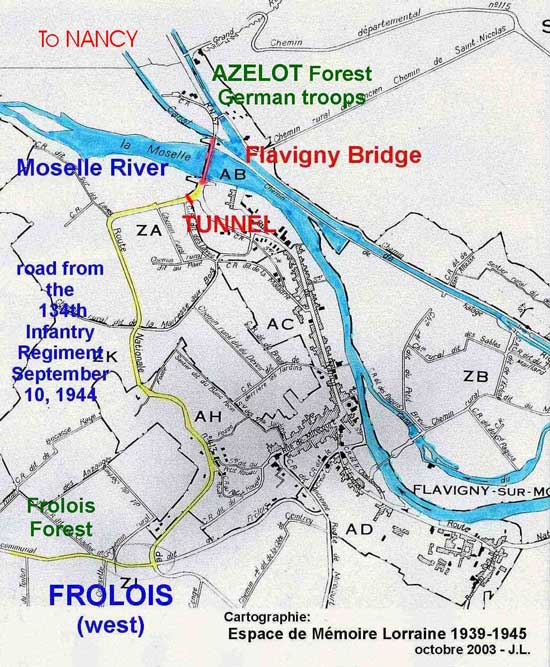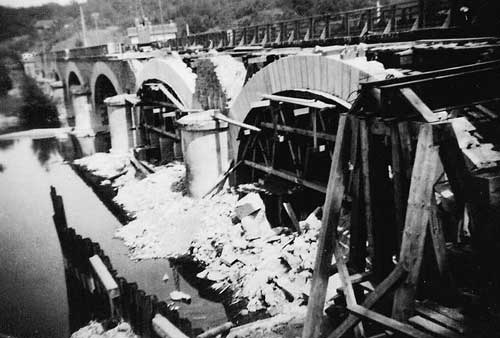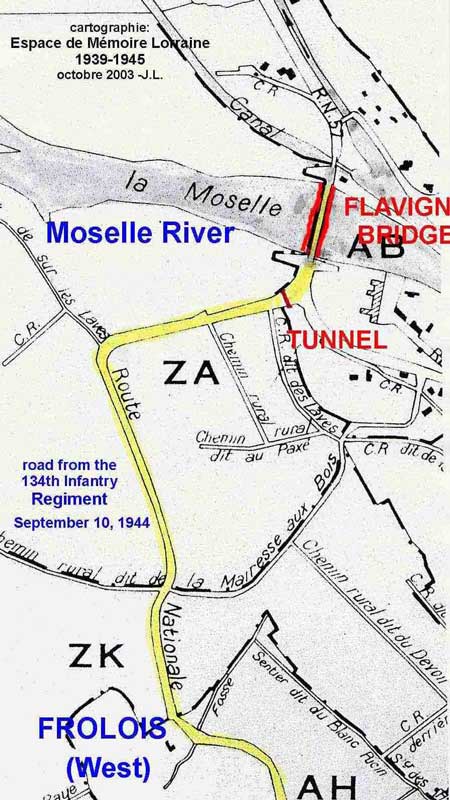
134th Infantry Regiment Website
35th Infantry Division Research Center
"All Hell Can't Stop Us"

 |
134th Infantry Regiment Website35th Infantry Division Research Center"All Hell Can't Stop Us" |
 |

The bridge at Flavigny, France - Photo taken October 1944
(Thanks to Frederick C. Roecker, III for this photo)
Excerpt From Official US Army History
2nd Battalion --Flavigny Bridge
Moselle River, France
On the morning of 10 September the 35th Infantry Division moved forward under scattered shellbursts to occupy the high ground west of the Moselle. Two regiments, the 137th Infantry on the right and the 134th Infantry on the left, were designated to make the crossing set for the following day. Engineer support would be given by the 1135 Engineer Group (Col. Charles Keller). The north wing of the division advance rested on the Moselle River loop and the southern wing swung eastward in line with the town of Vezelise.... The enemy was not in evidence and limited his opposition to artillery fire from guns earlier emplaced east of the Moselle. Shortly afternoon the tempo of the advance accelerated when word reached the 35th Division headquarters from the 134th that there was a bridge, mined but still intact, on the Moselle near Flavigny. General Baade gave Col B. B. Miltonberger, commanding the 134th Infantry, permission to push for this bridge. Colonel Miltonberger passed this information to his 2d Battalion, which reached the bridge after a sharp skirmish with the German infantry and armored cars west of the river in the Moulin Bois, and about 1900 began the crossing. Three hours later most of the battalion was dug in on the east bank of the Moselle near the bridge exit. But for some reason the tank destroyers, ordered to hurry across the bridge and support the American infantry, did not arrive. Up to this point fortune had favored the Americans and the enemy had failed to react in any force. About midnight German planes dropped bombs near the bridge but without making a hit. Then the German field guns took over the job and with a few accurate salvos smashed the structure, leaving the 2d Battalion (Maj. F. C. Roecker, Jr.) stranded on the enemy bank. For two and a half hours enemy shells fell unremittingly on the American position and casualties mounted. At last the German counterattack, delivered by infantry from the 104th Panzer Grenadier Regiment of the 15th Panzer Grenadier Division and paced by tanks, swept in on the decimated and shaken battalion. Losses inflicted on the Americans were very high. Those who could escaped through the night and swam or waded back to the west bank.
Hugh M. Cole, United States Army in World War II, The European Theater of Operations, THE LORRAINE CAMPAIGN, Washington D. C., 1984, Page 71.
Letter Written by F.C. Roecker Jr., Dated 9-16-86
Battle of Flavigny
General (then Major) Frederick Roecker commanded the 2nd Battalion, 134th Infantry Regiment at the time of this battle.
Dear Son,
Reference the "Flavigny" Bridge, this will be short but what I remember over 40 years later.
It was not intended as a "Diversion" but it worked out that way. That is what General Baade (my Division Commanding General) told me on my return from the hospital. It could not have been planned as a Diversion since no one knew the bridge was intact until I saw it and reported the bridge intact across the Moselle to Regiment. In other words it was not a deliberate set-up, but ended up as a diversion allowing the 137th Infantry to make a river crossing without too much opposition. The Germans had (according to General Baade) concentrated on preventing the bridge capture. When they found it taken they threw all they had at us.
Now we have the bridge established as an objective of opportunity. We had been fighting for days with no relief. On that day we had driven the Germans from high ground on our side of the Moselle. My battalion (BN) was leading the Regiment. My leading element reported the bridge intact to me. I went with field glasses to see what the true picture was. We were on the top of the high ground about 700 yards from the bridge with the terrain gently sloping toward the bridge. The bridge was intact. It was about 1700 hrs (as I remember) when I reported the bridge intact to Regiment. I don't know what time the official books say, but this is how I remember.
Reg't contacted Division and I was told to take the bridge without delay. I requested that they let me go for it the next morning at about 0400, but was told no. I was then told that my battalion would immediately be followed by the 1st BN. Also, I was promised 9 BNs of Arty on call.
I had my Company Commanders (C.O.s) and Pioneer Platoon Leader meet me at my vantage observation point and issued the attack order. F Company (Co). and Pioneer Platoon to go first with Pioneer Platoon directed to de-mine the bridge. We could see it was mined. My Bn F.O. (Artillery Forward Observer) was with us. E and G Companies were to advance abreast at the same time ready to follow F across the bridge. I also had double rations and extra ammunition issued to the companies.
We jumped off about dusk. F. Co. reached and crossed the bridge with but little resistance. The Pioneer Platoon removed all the demolition charges. E and G Co. crossed the bridge and expanded the bridgehead. I had moved down directly behind F. Co. with my S-3, Radio Operator and Runner. Then we were hit with infantry fire. The 1st Bn that was supposed to follow us got lost and never got to the bridge. Instead of 9 BNs of Artillery, I found I had just a portion of one Bn. The rest were displacing. In essence, we had the bridge but none of the promised support. My 81mm mortars gave us support and our heavy 30 MG gave us support. It was getting dark.
I had crossed the bridge with F Co. My forward Command Post (C.P.) was under a culvert on the friendly side of the bridge. In all, I crossed the bridge 4 times that night. It seemed about 8 PM (2000 hrs) that we started receiving Arty fire on the bridge, etc. The only way you could cross it was on your belly due to enemy MG fire. The bridge had 3 ft (about) sidewalls.
From then on we were hit by what seemed to be all the "Jerries" had on their side of the river. When I returned to my forward C.P. the 1st time, I tried to radio to get the promised assistance. Nothing came. I crossed back again and I remember giving Lt. Brennan, the F. Co C.O. a cigarette. He had lost an arm and a leg. I saw the new F Co. C.O. talk things over, and started to return to my forward CP. I was wounded on the way. I did not think it bad but when I got back to my forward C P my radio operator told me he thought I had an artery hit as I was bleeding badly. He cut open my sleeve and put on a tourniquet. It was then about 2300. I stayed about an another hour until my exec. arrived to take over. Then I got up the hill and into a jeep back the Reg't aid station. My Reg't C O met me there and I briefed him. At the Div Clearing Co, they gave me blood and put me to sleep. I was air-evacuated and woke up in a hospital near Cheltenham, England.
Well, that is the story. When I reported back to the division from the hospital I really was mad at the Division C/S (Chief of Staff). I spoke my piece. Gen. Baade then had me come in to his office -- told me my BN was still mine and explained that the action had proved a diversion for the 137th crossing.
I lost quite a few men but not as many as one might think, as I was under strength when I attacked. F. Co. was pretty much lost, but after the bridge was destroyed many of the others managed to return to the friendly side swimming and wading. After talking to General Baade, I returned to my Battalion and resumed command.
Story Ends.
All in all it was a bloody difficult night --- plenty bloody. I still get letters from men that went with me on that attack. Oh yes, they gave me more blood in England.
P.S. Son this is the best I remember. It may differ from comments I have made in the past but I did my best to remember. Hope that you can read this ------ Also, the above illustrates why a commander cannot get too close to his men in combat. It hurts too much to see close friends killed. He has to get a bit hardened on losses.
Thanks to Frederick C. Roecker, III, LTC, USAR (Ret.) for permission to post this letter from his father and the Official U.S. Army History excerpt.





Web page dedicated to Frederick C. Roecker, Jr.
Web page dedicated to Pvt Wiley T Allen who was wounded at Flavigny
Web page dedicated to Pfc. Albert Bloom who was wounded at Flavigny
Web page dedicated to Pfc. Calvin C Mordecai who was wounded at Flavigny
Web page dedicated to S/Sgt Joe D. Dozier who was taken POW during the battle at Flavigny
First hand account of the battle by Sgt Edward A Farris, Company G, 134th Infantry Regiment
Picture a of the Monument at Flavigny, France